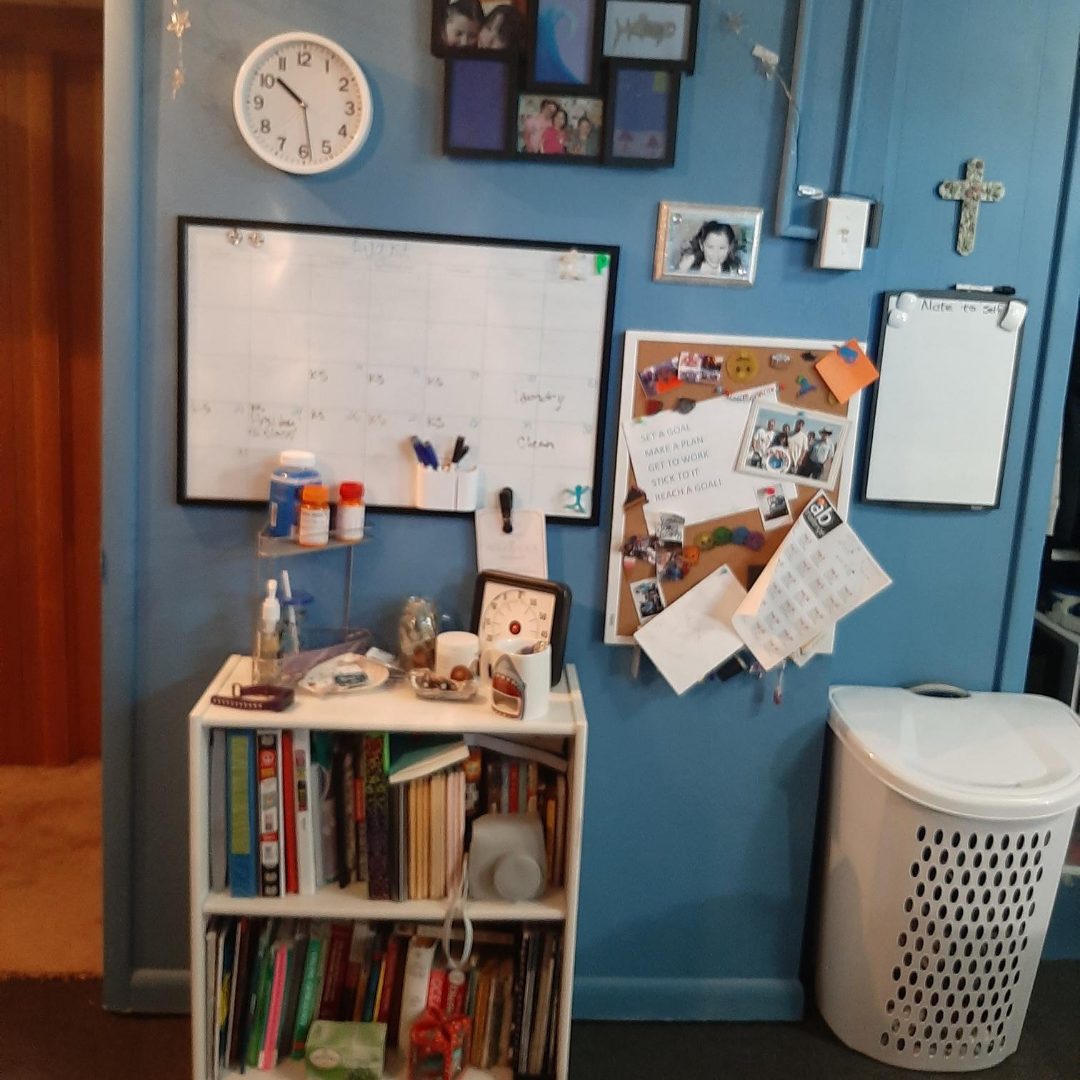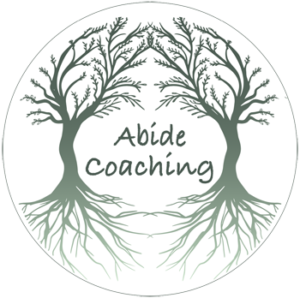For my clients, their environment has always been a critical factor in how they feel. Now that we are months into this new reality, our settings are even more important.
My daughter, Paige, works full-time, goes to college part-time, and has loads of neurodiverse challenges, including being hyper and hypo sensitive to lights, sounds, textures, and temperatures. She has come a long way; however, she still needs to place to recover and restore herself to live in our society, which is not set up for the neurodiverse.
Here I am going to use her room as an example of how an environment can be supportive.

Living in a landlocked state is hard on a girl who’s happiest at the beach, yet this is precisely where my daughter is. Her room has been designed to give her functionality, comfort, and calmness. We will start right at the door to her room; the mirror may appear to be on the wrong side of the door to you, but not to us. This mirror is not for looking at herself. For full disclosure, the door used to hang in the opposite direction, but we knocked down and added walls to make her room bigger. When the door was re-used here, the handyman asked if we wanted the mirror taken off. I said no. It is how I leave messages her. She can choose to read them whenever she is ready to take in more information, which is often not when she arrives home. Her job has long hours, is physically demanding at times, and requires her to interact with the public regularly, which she finds draining on all levels. Sometimes the messages get her attention right away, and sometimes they don’t; either way, they aren’t going anywhere.

Once inside, to the left is what I like to call ADHD central.
The big clock is easy to read, allowing her to quickly know when getting ready to leave for the day. It also was chosen because it didn’t tick too loudly. The calendar gives her an overall picture of the month. It is mostly used to know when cleaning and laundry need to be completed. Specific appointments are on her phone with reminders. Her meds are here on the left, which she has chosen to take daily, along with a cup of water that has a lid since she is barely awake when she takes them. The time timer, on the right, is not her favorite tool, but it works when she needs to get through tasks quickly. Next to the bookcase is where she dumps her backpack.
Right in front of the door, there is a craft space for her to use. She only sits at the desks to do crafts. Next to the desk are cubbies that are filled with all kinds of stuff. Each cubby bin is labeled with what goes in it, but inside of each isn’t particularly organized. T
T hey don’t need to be. The mess is covered up by the solid cubby, and looking inside isn’t overwhelming. Paige can find what she needs, so this is organized enough for her. You may be wondering what is next to the cubbies in the corner. It is mostly craft supplies that are too big to fit in the cubbies but there is also a milk crate with files. Only open storage works if you want filing to get done. Yep, that is a basket of laundry waiting to be put away under the desk. No system is perfect.
hey don’t need to be. The mess is covered up by the solid cubby, and looking inside isn’t overwhelming. Paige can find what she needs, so this is organized enough for her. You may be wondering what is next to the cubbies in the corner. It is mostly craft supplies that are too big to fit in the cubbies but there is also a milk crate with files. Only open storage works if you want filing to get done. Yep, that is a basket of laundry waiting to be put away under the desk. No system is perfect.
In the middle of the room is her bed. It is cover ed with pillows. So many pillows!! On top of the bed is a weighted blanket. This blanket helps her anxiety. She sleeps more deeply and more calmly. Before this blanket, her bed looked like a tornado it nightly. She still moves around but much less. The headboard there are things she wants nearby like her white noise machine. Next to the bed is a fuzzy area rug that she likes to see as much as the feel of on her feet. Under the bed (but not pictured) is Paige’s portable desk system. It has all the supplies she could possibly need to do any homework. It is important for Paige to be comfortable while doing homework if she wants to stay focused. Being uncomfortable is a big distraction for her. She has been using this portable desk system since middle school.
ed with pillows. So many pillows!! On top of the bed is a weighted blanket. This blanket helps her anxiety. She sleeps more deeply and more calmly. Before this blanket, her bed looked like a tornado it nightly. She still moves around but much less. The headboard there are things she wants nearby like her white noise machine. Next to the bed is a fuzzy area rug that she likes to see as much as the feel of on her feet. Under the bed (but not pictured) is Paige’s portable desk system. It has all the supplies she could possibly need to do any homework. It is important for Paige to be comfortable while doing homework if she wants to stay focused. Being uncomfortable is a big distraction for her. She has been using this portable desk system since middle school.
 The closet at the foot of the bed has no door for easy access.
The closet at the foot of the bed has no door for easy access.
There are touch lights inside. She hangs almost everything. No dresser in this room; she hates folding clothes. Some items like sweaters that shouldn’t hang are in the drawers. On one side of the closet, there are baskets for socks and underwear. The personal care items that she uses in her room are stored in  her room. There are a few hooks on the other side for belts and hats. A laundry hamper with wheels (east to transport) on it sits on one side of the closet and on the other side are two hooks for jackets for that season.
her room. There are a few hooks on the other side for belts and hats. A laundry hamper with wheels (east to transport) on it sits on one side of the closet and on the other side are two hooks for jackets for that season.
Are you noticing the love for the beach and the sharks? The shark-shaped labels. The fish tank. The shells on the shelves. Sharks on the comforter under the weighted blanket. Even the blue walls.
 On the other side of the bed is a feature wall. It is painted dark blue, and half of it is covered in shells. Each shell was handpicked from a beach; we have been going to for family vacation all of Paige’s life. These shells add visual interest, tactile experience, and loads of pleasant memories to the room. Also, on the wall, a sign saying that the beach is her happy place and a collection of quotes about why the ocean, especially sharks, are vital to the earth. A soft round chair is at one end of the wall and at the other the mirror for looking at herself in which was mine as a teen.
On the other side of the bed is a feature wall. It is painted dark blue, and half of it is covered in shells. Each shell was handpicked from a beach; we have been going to for family vacation all of Paige’s life. These shells add visual interest, tactile experience, and loads of pleasant memories to the room. Also, on the wall, a sign saying that the beach is her happy place and a collection of quotes about why the ocean, especially sharks, are vital to the earth. A soft round chair is at one end of the wall and at the other the mirror for looking at herself in which was mine as a teen.
The carpeting over the whole floor is made from recycled plastic bottle chosen because it keeps plastic out of the ocean.
This room is the right room for Paige.

When creating a space for yourself. It should:
- Create a sense of calm.
- Have simple set-ups for habits to be successful.
- Be comfortable.
- Be easy to keep clutter-free.
- Be organized enough for you.


